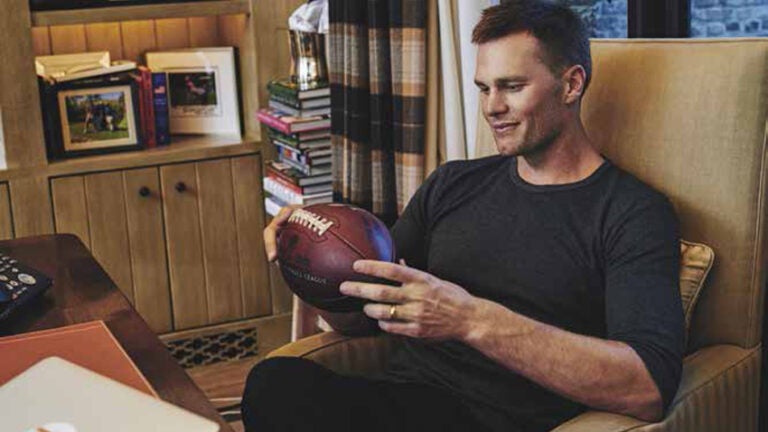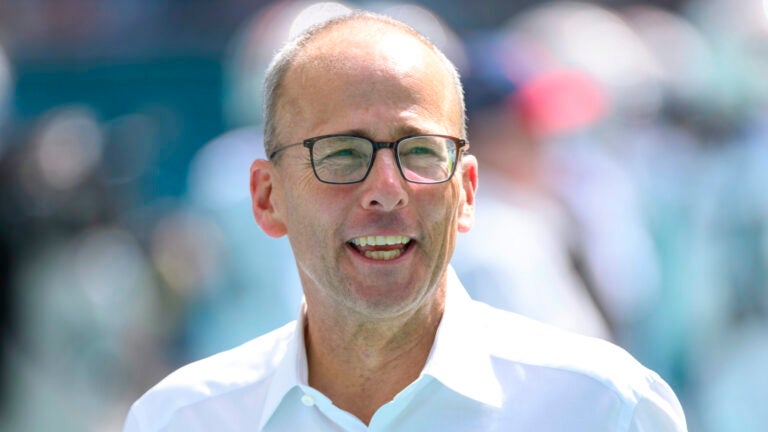What health and medical experts say about the advice in Tom Brady’s new book
"I think he has a very unique lifestyle."

Since the release of his comprehensive book, “The TB12 Method,” Tom Brady’s guide to “sustained peak performance” has been a New York Times best seller while simultaneously receiving its share of scrutiny. Recently, Brady responded to some of the criticism.
“It’s really my experience, so I don’t think anyone can tell me what my experiences have been,” Brady said on WEEI sports talk radio show Kirk & Callahan. “This is stuff, like I said, that I have been doing for a long time. When you’re in sports for as long as I have have been, there are a lot of things you have either confirmed, or really not confirmed the things I talked about. I really have a great feeling of what I believe works and doesn’t work.”
Determining what “works” and what “doesn’t work” is where Brady’s views diverge from authorities in fitness and medical fields. One of the primary critiques of “The TB12 Method” has always been that a large portion of it isn’t scientifically proven one way or the other. Now that the book is out, experts in various fields have had time to analyze specific aspects of the “Method.”
Here’s what they had to say:
What Tom Brady says: The TB12 Method’s is applicable to “anyone”
Part of Brady’s stated reason for writing the book is to help spread awareness of the system that has helped him. His goal is to “inspire a movement that radically reforms the way we train and helps us live a more natural, holistic, healthy lifestyle while lowering our risk of injury, increasing our vitality, and taking our performance to the next level.”
The target audience for Brady is “not only elite athletes but anyone and everyone who’s willing to commit to living a life of wellness and vitality–casual athletes, weekend warriors, yoga practitioners, marathon runners, anyone.”
What experts say:
Dr. Jessica Flynn, who specializes in sports medicine in the Boston area, concurs that – at least to a general level – Brady’s TB12 Method can be used by a wide group of people.
“I think anyone can do it, I agree with him,” Flynn said. “It just depends on what their goals are. That will also determine how much of it you do. Maybe someone just looks at the resistance bands exercises and thinks that it’s a great manual, and starts doing those exercises. They’re great. They’re not going to harm anyone, as long as you work into them slowly, it could be used for absolutely anyone.”
Eric Rimm, a professor of epidemiology and nutrition and the director of the program in cardiovascular epidemiology at the Harvard School of Public Health, explained his thoughts in terms of a nutritional focus.
“I think he has a very unique lifestyle. Some of which is working out a lot. And burning a lot of calories because of his day job. I think that puts him in a slightly different class of individuals in terms of their nutrition and in terms of their nutritional needs,” said Rimm. “So while the book might be written for a high school athlete or a farmer or a doctor, very few people will burn as much energy and will be as active during the day, like during the entire day of every day of the week.”
What Tom Brady says: Young athletes using the TB12 Method
As Brady reasons, “If I’d begun pliability training when I was fifteen or sixteen years old, I wouldn’t have had to endure so many years of unnecessary pain, as so many athletes do.”
What experts say:
Dr. Flynn mentioned Brady’s reference specifically in answering a question about her reaction to the book.
“Just because it worked for Tom Brady, it’s not necessarily going to work for a 16-year-old kid. As an example, Tom Brady says if he had just started doing this when he was 16, he would never have dealt with all of the pain and injury that he dealt with growing up. And the fact is we don’t really know that. We don’t know what would happen to a 16-year-old if they started doing this method at that age. We don’t know what kind of athlete they could be by the time they’re 40. We just don’t have that information yet. So I really hope that their next step is to start studying this stuff.”
Mike Fantigrassi, who is the director of services for the National Academy of Sports Medicine (and is an NASM master instructor), also discussed the uncertainty of younger participants in the TB12 Method.
“One of the things that I would say would be concerning is if you have younger athletes doing this program, there are a lot of variables you don’t know with this type of stuff,” Fantigrassi explained. “And the research can only answer a hypothesis, which is one question. It takes a long time to do research and understand what’s going on, but he mentioned doing weight training previous to using the bands. So one of my questions is do you need to have a good base of strength training?”
“I will say that I personally wouldn’t use that strategy with a youth athlete, or a high school athlete or a college athlete,” said Fantigrassi.

Tom Brady works on his pliability
What Tom Brady says: alkaline-forming vs. acid-causing
In regards to his very strict diet, Brady says he subscribes to “the philosophy and principle of eating 80 percent alkaline-forming and 20 percent acid-causing foods.”
What an expert says:
Rimm explained that this is an area where Brady’s natural bias as an elite athlete in the 18th year of his professional career is important to note.
“That’s one that a lot of people have written about, where there’s great interest in trying to understand the interactions between foods and just sort of our natural metabolism,” Rimm said. “It’s very tricky because he’s focused on one area: feeling healthy at 40 years old.”
“There’s actually a substantial amount of science that suggests that lycopene, which is very high in tomatoes, is beneficial for lowering the risk of prostate cancer,” Rimm continued. “So I hate to focus just on one aspect of a constituent of the diet, and say, ‘OK, therefore this food is all good and this food is all bad.’ Because that’s not the case. We have seen people who have higher consumption of tomatoes and lycopene have much lower risk of prostate cancer, so obviously that’s not something that a 40-year-old professional athlete is thinking about. He’s thinking about other aspects.”
What Tom Brady says: Pliability and optimal strength
As Brady asserts at the beginning of the chapter titled “Workouts,” he believes his regimen differs from traditional methods because of its objective.
“The goal of traditional weight training is to create maximum strength – which is different from optimal strength. Maximum strength refers to the most/longest model, which I talked about earlier – doing more reps of more weights – whereas optimal strength is the strength that you need to carry out the job you have to do. The goal of pliability is optimal strength.”
What an expert says:
“I do agree that for each sport, there’s probably what you would determine as an optimal level of strength,” Fantigrassi acknowledged. As for being able to treat it as an exact science, he was skeptical.
“Is that something that can be defined? Or is there a measurement to determine that? No, so it’s kind of a subjective thing.”
As for pliability, Fantigrassi said that there are similarities in existing training programs.
“Something that we teach at NASM is called an integrated training model. So basically what that means is we use flexibility, which is similar to what he’s calling pliability in the book, and then also core balance reactive, which is planned metrics for jump training, speed agility quickness training, and then different forms of resistance training. And the resistance training can really take on any form of lighter loads done for higher repetitions all the way through lifting, heavier loads, and then more explosive weight as well. So for an athlete, typically you want to include all of those different components, and if the training program’s designed well, you’ll get the outcomes you’re looking for, which is good muscle balance, the right amount of strength.”
What Tom Brady says: Neural priming
Brady describes a three-pronged approach to brain training: neural priming, mind-set/attitude, and brain games. Brady calls the first step in his brain-training process “the neural priming that takes place during pliability.”
“By creating physical stimulus — what we call ‘positive and intentional trauma’ — before and after a workout or game, my brain and body learn how I want my muscles to function during practice or game competitions,” he writes. “Muscles naturally tighten when they contract or when they take a hit, but if I train my brain, and by extension my muscles, to remain in a long, soft, primed state, they’ll perform more optimally, with lower risks of injury, by absorbing these forces.”
What experts say:
Dr. Nate Zinsser, director of the performance psychology program at the Center for Enhanced Performance at West Point United States Military Academy, says Brady is learning to be comfortable while being uncomfortable.
“Any serious weight-lifting regimen or any serious weight-lifting workout is intentional trauma — you’re making your muscles work at a rate that they really don’t want to, but you’re forcing them to,” he said. “And so your brain learns to accept that level of function and you have to practice relaxing then in that environment. I don’t think I would express it that particular way, but I don’t think he’s far off the mark.”
Dr. Karen Rommelfanger, program director of Emory University’s neuroethics program at the Center for Ethics and an assistant professor in the department of neurology, said the process Brady is describing is specific and applicable to him and how his body works.
“It’s not necessarily like this is a targeted technique we would study in the lab and that we understand that he is somehow able to elicit a chain of reactions in his brain to change the way his body responds to hits in football, like he now will I guess without even thinking consciously about it, his body will stop taking the hits as hard,” she said. “Honestly, it’s not necessarily that it doesn’t make sense, it’s just also kind of not really doesn’t sound very scientifically grounded. It’s just, ‘This is the way I see my body,’ and that’s fine. But it’s not something I would say we’ve tested in the lab, for example.”

Tom Brady sells TB12-branded electrolytes as part of his performance method.
What Tom Brady says: Mental toughness
For the second step in his brain-training regimen, Brady emphasizes mindset and attitude.
“Remembering to maintain the right mental toughness, and also that it’s a choice we make every day to be and stay positive,” he writes.
What experts say:
Zinsser said that sentence is a simple way to describe an entire field of study, but that a person’s outlook is fact a choice.
“What do we really mean by the right mental toughness?” he said. “We have to learn how to think in a way that makes us feel a certain way and that’s going to impact our body and that’s going to impact our execution.”
Rommelfanger described trying to study mental toughness the same way as trying to study love in the brain.
“[Mental toughness is] something more that would be in the realm I suppose of how you can conceptualize more holistically with psychology or a sociological sense. He can attribute that to his brain, but mental toughness, how does that manifest?” she said. “Is he thinking that that’s more robust executive functioning and so now his brain can resist making certain kind of decisions? I don’t know what that is except that he’s talking about a certain kind of courage and discipline. I’m not really sure that’s the same thing as prescribed scientific regimen.”
What Tom Brady says: Brain games
And the third prong is to play brain games, specifically his brain games created with BrainHQ. (Subscriptions are $14 monthly or $96 for the year.)
Brady writes that only his brain games show results. “There are other brain training programs out there, but studies have repeatedly shown that only these exercises translate to real-world activities. The exercises increase the speed and accuracy with which I take in sensory information and improve my ability to process, store, and retrieve information.”
What experts say:
However, Zinsser and Rommelfanger both said that no brain games on the market have actually been proven to “translate to real-world activities,” like Brady claims his do.
“I would not go so far as to agree with him on that particular point,” Zinsser said. “There are lots of people out there developing quote-unquote brain games, brain-training activities and I have yet to see any evidence that there is a transition or a translation of effectiveness or improvement in your performance on one of these games and improvement in terms of things you could measure on a playing field.
“All of these manufacturers are going to make the claim that you work on your eye-hand coordination, you work on your reaction time, you work on your decision-making abilities using these various games, but nobody can say that improvements in the performance on these various games — by Lumosity people or whatever — really means that you’re going to be better at catching footballs or noticing the opening of a receiver or being able to detect the release point of the pitcher’s fastball in baseball.”
Zinsser said what users of brain games likely experience is a placebo effect: Seeing an improvement playing a brain game can create confidence that translates to the field or other areas.
“You could almost make the point that all of these devices — Lumosity, BrainHQ, NeuroTracker, Dynavision — they’re all just placebos to get you to believe in yourself. You got to recognize that placebo is potentially quite powerful,” he said. “And when we’re talking about Tom Brady’s world, if that placebo gives you one half of one percent advantage over your opponent, that’s big.”
Rommelfanger called this the “holy grail”: That cognitive training can lead to, say, improving your memory and then not need a list at the grocery store anymore. But, she said, that simply has not been scientifically proven on a consistent basis with a large group of people.
“Actually even his brain exercises haven’t been proven to transfer into real-world activity,” Rommelfanger said.
“I don’t really want to crush anyone’s hopes,” she said. “If there’s any hope that we can try to gather is that while these studies generally have smaller populations and they look for generalizable outcomes — so what is generalizable true for everyone — and what’s true for everyone might not be true for the individual. There may be some exceptions where some people actually do gain some improvement, but scientifically this hasn’t been shown.”






